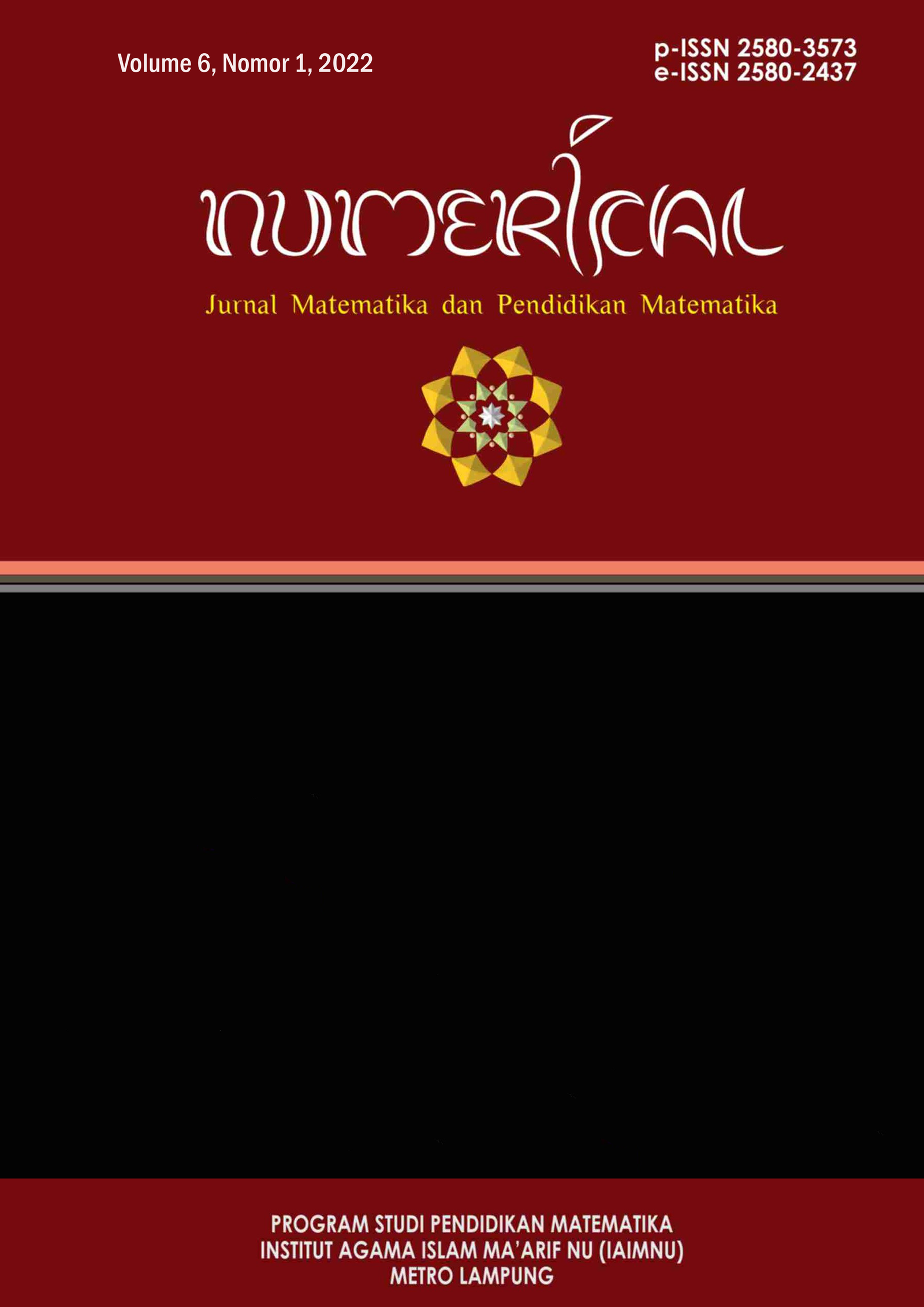Cognitive Flexibility in terms of Mathematics Education Student Learning Outcomes
DOI:
https://doi.org/10.25217/numerical.v6i1.1844Keywords:
Cognitive Flexibility, Creative Thingking, Critical ThinkingAbstract
Cognitive flexibility is the ability to think openly and be able to solve problems from different perspectives. People who have good cognitive flexibility will be able to learn faster, solve problems more creatively, and adapt and respond to new situations more effectively. This research method is a quantitative method of measuring the ability of cognitive flexibility as measured by questions that meet the indicators of cognitive flexibility with the object of research being the sixth semester student of one of the universities in the city of Bandung. The instrument consists of cognitive flexibility questions, theories about cognitive flexibility, and questionnaires. Processing of data by calculating the percentage of answering the questionnaire and scores of cognitive flexibility test scores in complex analysis courses. The results of the study showed that the ability to think openly, and many ideas and ideas about something was still low and the two abilities had a low correlation with lecture outcomes. So that the ability to think openly, and many ideas and ideas need to be improved so that students have an open mind and find new ideas in solving problems
References
K. E. Lestari, “Analisis Kemampuan Berpikir Deduktif Aksiomatik Mahasiswa Menggunakan Teknik Probing-Prompting Pada Mata Kuliah Analisis Real Lanjut,” Lemma Lett Math Educ, vol. 3, no. 1, pp. 20–30, 2016. DOI: https://doi.org/10.22202/jl.2016.v3i1.604
T. Masfingatin, W. Murtafiah, and I. Krisdiana, “Kemampuan mahasiswa calon guru matematika dalam pemecahan masalah pembuktian teorema geometri,” J. Mercumatika J. Penelit. Mat. Dan Pendidik. Mat., vol. 2, no. 2, pp. 41–50, 2018. DOI: https://doi.org/10.26486/jm.v2i2.272
S. Kurniawan, “Tantangan Abad 21 bagi Madrasah di Indonesia,” Intizar, vol. 25, no. 1, pp. 55–68, 2019. DOI: https://doi.org/10.19109/intizar.v25i1.3242
M. Muhali, “Pembelajaran Inovatif Abad Ke-21,” J. Penelit. Dan Pengkaj. Ilmu Pendidik. E-Saintika, vol. 3, no. 2, pp. 25–50, 2019. DOI: https://doi.org/10.36312/e-saintika.v3i2.126
M. Baker, R. Rudd, and C. Pomeroy, “Relationships between critical and creative thinking,” J. South. Agric. Educ. Res., vol. 51, no. 1, pp. 173–188, 2001.
E. Hanife, “The relationship between pre–service teachers’ cognitive flexibility and interpersonal problem solving skills,” Eurasian J. Educ. Res., vol. 18, no. 77, pp. 105–128, 2018. DOI: https://doi.org/10.14689/ejer.2018.77.6
B. Miri, B.-C. David, and Z. Uri, “Purposely teaching for the promotion of higher-order thinking skills: A case of critical thinking,” Res. Sci. Educ., vol. 37, no. 4, pp. 353–369, 2007. DOI: https://doi.org/10.1007/s11165-006-9029-2
W. Shim and K. Walczak, “The Impact of Faculty Teaching Practices on the Development of Students’ Critical Thinking Skills.,” Int. J. Teach. Learn. High. Educ., vol. 24, no. 1, pp. 16–30, 2012.
H. Sugilar, “Daya matematis mahasiswa program studi pendidikan matematika,” JNPM J. Nas. Pendidik. Mat., vol. 1, no. 1, pp. 97–108, 2017. DOI: https://doi.org/10.33603/jnpm.v1i1.252
A. Aprianto, H. Praherdhiono, and A. Wedi, “Pengaruh Pembelajaran Berbasis Masalah dengan Penguatan Keterampilan Fleksibilitas terhadap Hasil Belajar Kognitif,” Edcomtech J. Kaji. Teknol. Pendidik., vol. 6, no. 2, pp. 264–274, 2021. DOI: https://doi.org/10.17977/um039v6i12021p264
N. N. Oktaviani, P. K. Suprapto, and R. F. Mustofa, “Hubungan Antara Fleksibilitas Kognitif Dengan Keterampilan Pemecahan Masalah Pada Mata Pelajaran Biologi Di MAN Kota Tasikmalaya,” J. Bioterdidik, vol. 9, no. 1, 2020. DOI: https://doi.org/10.23960/jbt.v9i1.21745
E. O. Santosa and I. Setyawan, “Hubungan antara fleksibilitas kognitif dengan problem focused coping pada mahasiswa fast-track universitas diponegoro,” J. EMPATI, vol. 3, no. 2, pp. 139–146, 2014.
D. Kim, D.-J. Kim, and W.-H. Whang, “Cognitive Synergy in Multimedia Learning.,” Int. Educ. Stud., vol. 6, no. 4, pp. 76–84, 2013. DOI: https://doi.org/10.5539/ies.v6n4p76
Ionescu, T. (2012). Exploring the nature of cognitive flexibility. New ideas in psychology, 30(2), 190-200. DOI: https://doi.org/10.1016/j.newideapsych.2011.11.001
S. M. Sevima, “10 Tops Skills Paling dibutuhkan di Tahun 2025 Menurut Kemendikbud Dikti,” 10 Tops Skills Paling dibutuhkan di Tahun 2025 Menurut Kemendikbud Dikti, 2021. https://sevima.com/10-tops-skills-paling-dibutuhkan-di-tahun-2025-menurut-kemendikbud-dikti/
Five College of Ohio and Teagle Foundation. (2012). "Creative and critical thinking: Assessing the foundation of a liberal arts education". Retrieved from http://www.3.wooster.edu/teagle/creativity.php.
L. Qiao, L. Zhang, A. Chen, and T. Egner, “Dynamic trial-by-trial recoding of task-set representations in the frontoparietal cortex mediates behavioral flexibility,” J. Neurosci., vol. 37, no. 45, pp. 11037–11050, 2017. DOI: https://doi.org/10.1523/JNEUROSCI.0935-17.2017
I. Elia, M. van den Heuvel-Panhuizen, and A. Kolovou, “Exploring strategy use and strategy flexibility in non-routine problem solving by primary school high achievers in mathematics,” ZDM, vol. 41, no. 5, pp. 605–618, 2009. DOI: https://doi.org/10.1007/s11858-009-0184-6
Ülger, K. A. N. İ. (2016). "The relationship between creative thinking and critical thinking skills of students". Hacettepe Universitesi Egitim Fakultesi Dergisi-Hacettepe University Journal of Education, 31. DOI: https://doi.org/10.16986/HUJE.2016018493
Downloads
Published
How to Cite
Issue
Section
License
Copyright (c) 2022 Numerical: Jurnal Matematika dan Pendidikan Matematika

This work is licensed under a Creative Commons Attribution-ShareAlike 4.0 International License.







